One of the fun activities in your visit is taking a boat ride in the great harbor of Rotterdam, which is easy to reach on a scenic stroll along the harbor shore for about 800 meters that'll bring you to the boat company. The route brings you under the spectacular Erasmus Bridge opened in 1996. The harbor tour company is called Spido with a fleet of modern comfortable touring ships they operate year-round, and during the season from March through September they have departures every 45 minutes. You don't need reservations, just show up and buy your ticket right next to the Erasmus Bridge.
See the video about the harbor cruise here.
Rotterdam is the busiest port in the Netherlands, formerly the world’s largest, but still the busiest and most extensive in all of Europe, stretching out 40 kilometers covering over 100 square kilometers, or 40 square miles. Not only is it a major commercial area, but the downtown waterfront is a scenic and popular visitor attraction. The route begins under the spectacular Erasmus Bridge opened in 1996.

You really should take a boat ride in the great harbor of Rotterdam. Fit it in whenever you have the time. As mentioned previously, you could have boarded when you were at the waterfront after visiting the museums. Otherwise it’s easy to reach the dock by Erasmus Bridge from anywhere on public transit or a short walk. The harbor tour company is called Spido with a fleet of modern comfortable touring ships that operate year-round, and during the season from March through September they have departures every 45 minutes. You don’t need reservations, just show up and buy your ticket right next to the Erasmus Bridge. Details on their website:
.jpg)
Maybe the best part of the ride is that you’ll get vistas of the amazing modern structures that have gone up around the harbor. It’s the biggest collection of new skyscrapers in the country, some with a radical design by famous architects. You’ll also get a glimpse at the workaday world of harbor life, including the many dry docks where ships are repaired, and we will see the main activity of this harbor, which is loading and unloading the containers. It might seem that an industrial harbor is not the most exciting place to spend your precious time, but you don’t have to be a nautical buff to appreciate these sights.
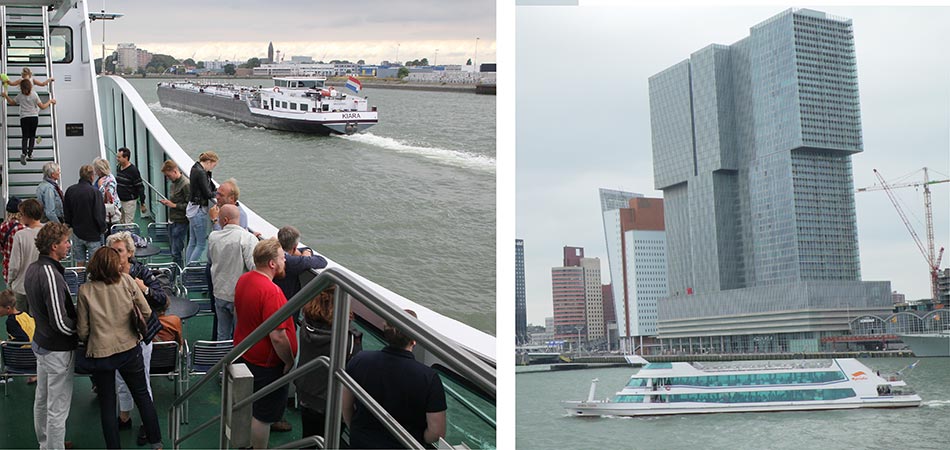
The first major building of the harbor cruise is the largest structure in the country, called De Rotterdam. It was designed by famous architect, Rem Koolhaas, a local man with offices based in Rotterdam. The giant building has 240 apartments, a hotel with 285 rooms and just as many offices, along with cafés, and restaurants and a fitness facility. The boat route makes a little round-trip going back and forth under that Erasmus Bridge so you get several views to take in this truly amazing structure.
Another huge building coming right up is De Maas glass tower, government headquarters for the Department of Public Works and Water Management. You’ll see lots of other boats buzzing by on the journey, such as water taxis speeding along and typical river cargo ships with living accommodations onboard, similar to what you saw at the Maritime Museum.

This ship is quite comfortable with seating inside or out on the upper deck, even though it can get windy and cool, the best place to see everything. You are free to walk around to look out both sides, enjoying views in all directions. Maybe go downstairs for a while into the cafeteria area and relax at a table with food and drinks.
You will get a look at the Euromast observation tower, at 185 meters high, the tallest observation tower in the country. Note for later the floating Chinese restaurant called Seafood Market featuring all-you-can-eat.
It’s wonderful the city is taking advantage of the long coastline they have with this harbor to build some condominiums with the view of the water. They’re designed with a nice variety of sizes, some of them very high, others low-rise and mostly mid-rise. Unfortunately, this new housing is quite expensive, especially with such a great waterfront location.
2up.jpg)
We’re coming up on a most unusual-shaped building with a strange top that sticks out. This is the Shipping and Transport College, 65 meters high, and that cantilever portion is a conference room. At this point you have reached the best location for seeing all of the major skyscraper buildings of the city clustered together. You will see them again on the return after passing another great landmark of the harbor, the SS Rotterdam, which began service in 1958 as a transatlantic passenger ship, well before the modern era of mega cruise ships.
In its day the SS Rotterdam was one of the most glamorous and deluxe ships afloat, in service for 40 years. Now permanently docked in the harbor, it functions as a hotel with restaurants onboard. Later you could come back and pay for a tour to walk through the different staterooms and the engine room and up on the decks and the bridge.
.jpg)
The ship’s main route was Rotterdam to New York, and now nearby is the former headquarters of its company, the Holland America line, nestled amongst the new skyscrapers. The grand old building used as starting point for the Holland-America cruise line is now the deluxe Hotel New York with a lovely café out front. The tall building behind it with the M on top was briefly the highest building in the country when it opened in 2005 with 152 meters. These skyscrapers are all clustered on a small peninsula called Wilhelminapier. Het Nationaal Fotomuseum (national photography museum) is around the corner at the Las Palmas Wilhelminakade, the previous Holland America Line workshop building. Their collection consists of many historical, social and cultural images from the Netherlands and elsewhere, with archival control over three million images taken by Dutch photographers.

Modern naval ships docked here are quite a contrast with the 100-year-old three-masted schooner, Opsterschelde, which is often cruising in the harbor. Thoroughly renovated in 1988, it sailed around the world two times since then and offers occasional day trips in the Rotterdam harbor and much longer voyages to the North Sea and elsewhere.
.jpg)
Next you leave those fancy skyscrapers and residential areas behind and arrive at the working harbor, cruising now through the port where they take care of business. This was the world’s biggest harbor from 1962 until 2004 but now the biggest ports are in Asia, especially Singapore and Shanghai. Rotterdam is the world’s sixth largest port in terms of annual cargo tonnage and the biggest in Europe.

This is also a major shipyard where all sorts of repairs are done using dry docks. They work on medium-sized as well as larger ships lifted from the water so the repair crew can gain full access. Every year 30,000 seagoing vessels come here, along with 110,000 inland vessels arriving by canal or river, serviced by 180,000 people who work in and around the port. With the 12 million containers handled here every year you could circle the world twice.
.jpg)
One big ship can carry 20,000 containers and there are 470 million tons of goods shipped here annually. The amount of steel passing through the harbor each day is enough to make 11,000 cars.
Every day 200 trucks are loaded up with fresh fruit and vegetables which are driven to all corners of Europe. This information is provided by the Port of Rotterdam Authority, jointly owned by the city and the country, which is responsible for ensuring the safe, smooth and secure operation of the port. They guide shipping traffic with a high-tech radar system similar to air traffic control at an airport.
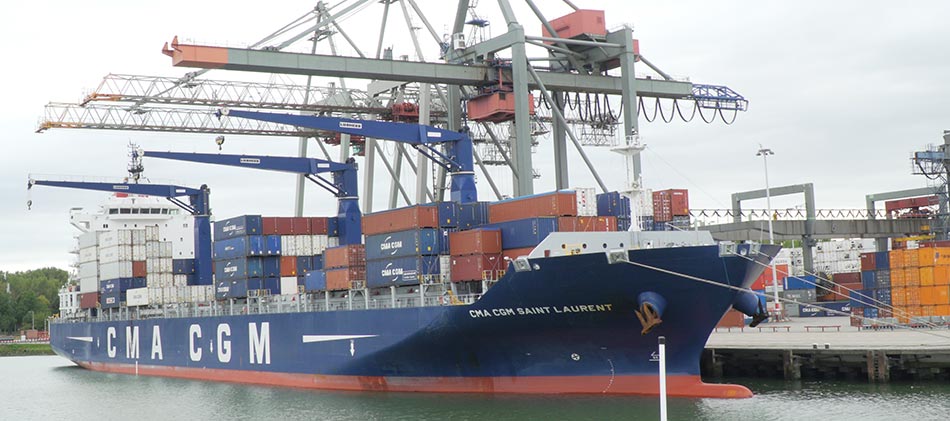
During the 75-minute cruise you’ll likely get a chance to see some container action being loaded or offloaded from a ship, with work done by robots, autonomous cranes acting with minimal human supervision, the only efficient way to deal with such huge volume.
A variety of other economic activities take place in addition to shipping, such as oil refining, plastics manufacturing, stripping the containers, recombining cargo loads, packaging goods for wholesale distribution, and so a wide variety of types of jobs are at work here, all of them highly skilled.
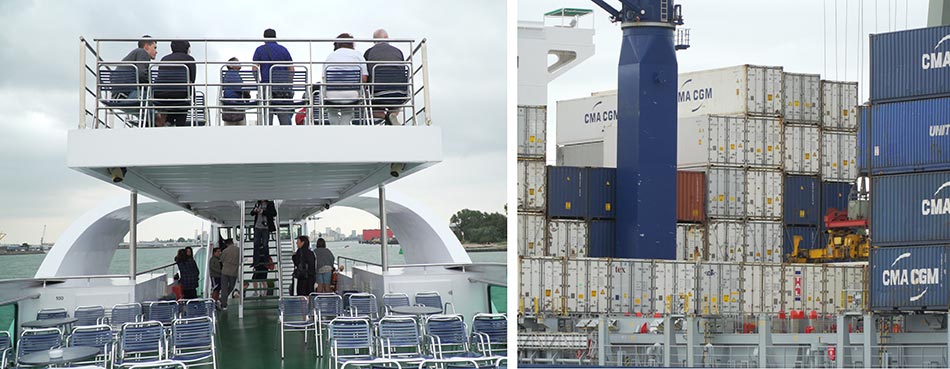
Our Spido ride only goes through a small part of the harbor, including the Damen shipyards where they repair boats, but the real harbor is no longer in the center—it’s 30 kilometers outside of the city, all the way to the North Sea. Huge containerships, which can be up to 450 meters long and carry more than 20,000 containers, don’t have to go all the way into Rotterdam.
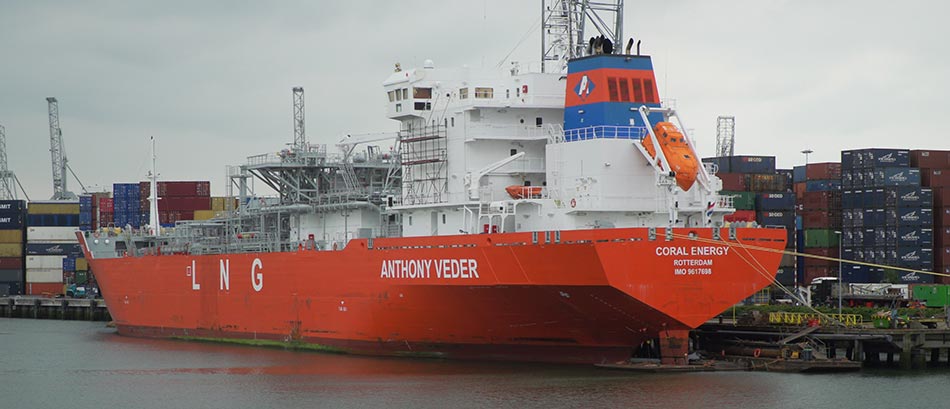
They just park their ship at the second Maasvlakte, a massive loading harbor near the North Sea, where the containers are loaded by robot cranes onto other ships, trucks or trains, and then delivered to the rest of Europe. This large area includes the petroleum harbor, coal harbor, with burning flames from Shell that light the city, the Slufter next to a chemical company, ICT and other tech companies located at the end of the waterway near the sea.
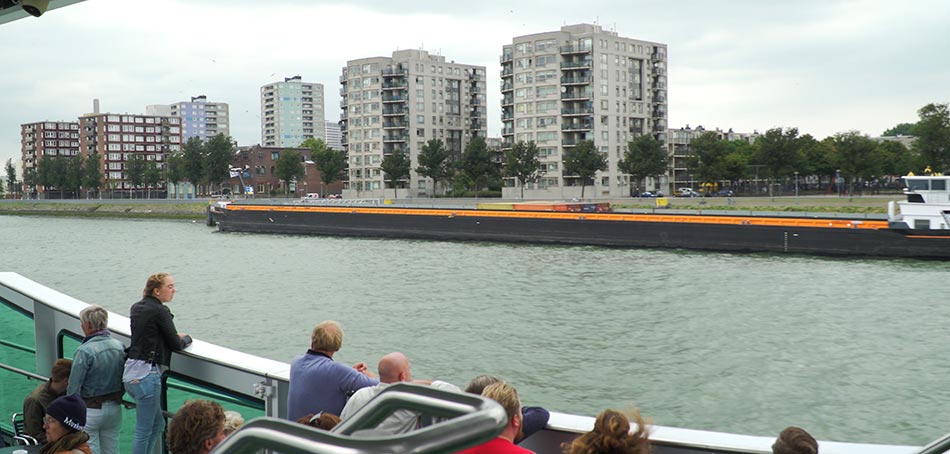
On the way back to the dock we pass more residential buildings, which completes our look at the harbor. There is a much longer 150-minute tour offered by Spido during the months of July and August, but you’ll probably find the 75-minute trip is just about right.
It is relaxing to be able to sit down, then walk around and move about the ship. You’re not going to get bored in that brief time, and there’s always the snack bar. Then you’ll be rested up for continuing your city explorations when you get back to the dock.
Be sure to look at our other Rotterdam pages